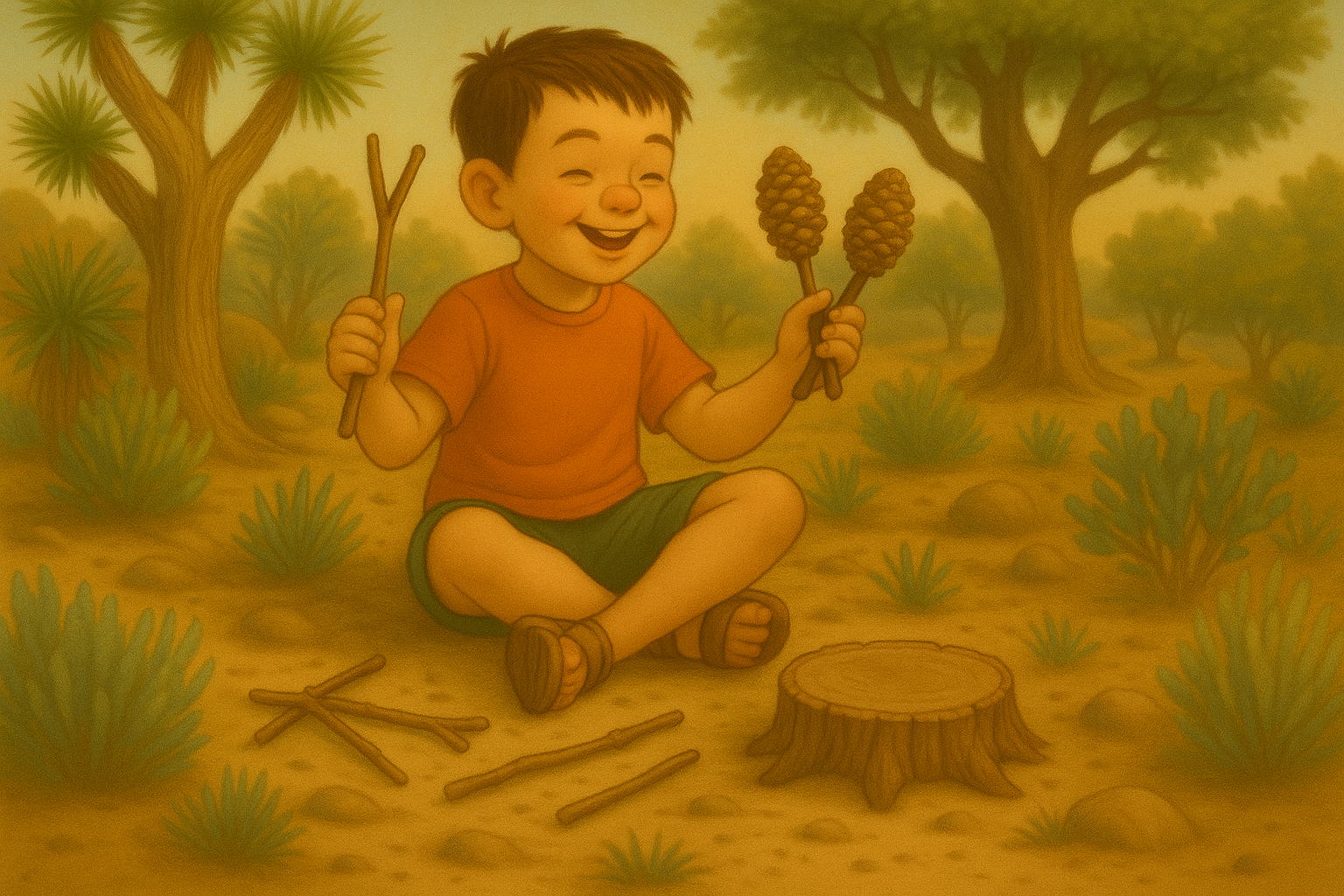Sprout Nature Explorer Series: How to Make Instruments from Tree Parts
By: Tom Baal
There’s music in the trees—you just have to listen for it. Not the birdsong or the breeze through the leaves (though that’s part of it), but the sounds waiting inside the trees themselves. The creak of a branch, the tap of twig against bark, the soft percussion of seed pods falling on dry earth. Nature’s been playing for a long time. Now it’s your turn to join the band.
At Tip Top Arborists, we care for trees professionally—but we also love seeing how kids interact with them creatively. This Sprout Nature Explorer adventure is all about turning twigs, bark, and other tree treasures into real instruments. Not fancy ones. Not expensive ones. But joyful, backyard-built, imagination-powered tools that help kids connect with trees in a whole new way.
So if you’ve ever walked through the yard or park in Lancaster and thought, “That branch looks like a drumstick,” you’re absolutely right. Let’s make some music.
Ever tap a hollow log and hear it echo back? That’s your first instrument right there. Bark has texture and tone—thick, papery, soft, or solid—and when you gently knock on a piece laid across a bucket or bowl, it can boom like a real drum. To make your own bark drum, find a sturdy piece of fallen bark (never peel bark off a living tree!). Lay it across a clean plastic container, empty pot, or even a small trash can. Use your fingers or a stick to tap different rhythms. Kids can decorate their “drums” with leaves, seeds, or safe paint. Want to get scientific? Try comparing bark from different tree types in your area—like pine, oak, or palm—and see which sounds best.
Lancaster’s climate means plenty of trees drop dry seed pods and twigs year-round. These are perfect for rhythm-making. Here’s how to build a basic tree shaker: collect a few dry seed pods (acorns, eucalyptus bells, jacaranda pods work great). Place them inside a paper cup or small jar. Seal the top with tape or fabric. Tape a twig to each side as a handle. Shake it up! You’ve got a maraca made from what nature left behind. No batteries. No plastic. Just rhythm and creativity. For safety, avoid pods with sharp edges or anything still sticky or green—they’re not ready yet.
This one takes practice, but it’s worth the effort. Certain flexible leaves—like those from magnolia or avocado trees—can become whistles if you stretch them just right. To play, hold the leaf between your thumbs with a tiny gap in the center. Press tightly and blow through the gap. If the wind catches just right, the leaf will vibrate and make a sharp whistle. It’s a bit like playing a blade of grass—kids who love a challenge will enjoy mastering this one. Bonus tip: find different leaf types and compare their sound. Broader leaves might buzz, while thinner ones squeal.
This is a favorite. Every stick has a sound—it just takes the right setup to bring it out. Make your backyard xylophone like this: collect dry sticks of different lengths and thicknesses. Lay them side-by-side on a log, bench, or stretch of mulch. Use another stick to tap each one gently. Kids will discover which pitches are high and low, and they can even try arranging the sticks by size for a real musical scale. Want to go next-level? Let them paint each stick a different color and name the notes themselves.
Don’t overlook the little stuff. Pinecones make excellent clackers when tied together with string, and dangling acorns can become gentle bells in the wind. Tie two small pinecones together with string, leaving enough slack to swing them into each other. Or hang a few hollow acorns on thread and tie them to a stick to make a chime. Great for younger kids who like sound but aren’t ready to build full instruments. These also double as decorations for your backyard “forest concert.”
Aside from being a fun way to keep kids busy and curious, tree instruments are a natural way to teach respect for the environment. When a child creates something joyful from a fallen branch instead of a store shelf, they start to see trees as more than scenery—they become teachers, tools, and even friends. This kind of play also encourages creative thinking, turning a stick into a sound machine takes imagination. It improves listening skills—nature’s music is subtle—tuning in is a skill in itself. It also fosters environmental appreciation. Kids learn not to take from live trees and to work with what nature offers. At Tip Top Arborists, we believe caring for trees starts with noticing them. Playing with them, even gently. These projects are a fun first step.
Only use dry, fallen parts—never cut or break from living trees. Avoid any sharp seed pods or brittle bark. Supervise young kids with tools like scissors or wire for tying pieces together. Check for insects or allergens before collecting materials.
Once your instruments are made, hold a nature jam session! Invite neighbors, record a forest song, or build a little “stage” with leaves and logs. Call it Sproutstock if you like. You might even try composing your own piece called “Lancaster Tree Symphony”—featuring bark drums, twig maracas, and a solo pinecone clack. Nature’s got rhythm. So do you.
Did you know the didgeridoo, a traditional Australian instrument, is made from eucalyptus trees hollowed out by termites? Wood type affects sound quality—that’s why guitars made from spruce or mahogany have different tones. Scientists have recorded trees “singing”—their branches and leaves vibrate at different frequencies in wind and rain.
Can you make tree instruments with your class or scout group? Absolutely! Just make sure to teach kids to collect responsibly and clean up afterward. What if you can’t find seed pods or bark in your area? Substitute with things like dried beans, paper towel tubes, or craft sticks—but keep the tree theme! Do trees get hurt when we use their parts? Only if we take from living trees. If it’s already fallen, nature’s giving you a gift—just say thank you and don’t take too much.
A cheerful child sits cross-legged in a sunlit backyard with twigs, bark, leaves, and pinecones scattered around. The child is tapping a handmade bark drum while smiling, with other nature instruments nearby. Background trees frame the scene in warm afternoon light.
Sprout’s friends use twigs and seed pods to turn the backyard into a musical forest!
Child playing homemade bark drum in a sunny backyard surrounded by tree-based instruments.
A joyful moment of nature play featuring a child making music with instruments crafted from fallen tree parts—twig maracas, bark drum, and pinecone clackers.

Sprout’s friends use twigs and seed pods to turn the backyard into a musical forest!
Ready for a Backyard Concert?
Hi friends, it’s me, Sprout!
Once your instruments are made, hold a nature jam session! Invite neighbors, record a forest song, or build a little “stage” with leaves and logs. Call it Sproutstock if you like.
You might even try composing your own piece called “Lancaster Tree Symphony”—featuring bark drums, twig maracas, and a solo pinecone clack.
Nature’s got rhythm. So do you.
Remember: Every tall tree starts with someone who cared enough to water it.
FAQs About Tree Instruments!
Can I make tree instruments with my class or scout group?
Absolutely! Just make sure to teach kids to collect responsibly and clean up afterward.
What if I can’t find seed pods or bark in my area?
Substitute with things like dried beans, paper towel tubes, or craft sticks—but keep the tree theme!
Do trees get hurt when we use their parts?
Only if we take from living trees. If it’s already fallen, nature’s giving you a gift—just say thank you and don’t take too much.
Look for signs like dead branches, cracks in the trunk, or unusual leaf loss.
Tip Top Arborists
Since 1976, Tip Top Arborists has been Southern California’s trusted partner in professional tree care. Based in Lancaster, CA, and surrounding areas—delivering expert tree trimming, removal, and maintenance services with safety, science, and integrity at the core.
We’re not your average “guys with chainsaws.” We’re ISA Certified Arborists with deep industry knowledge, modern equipment, and a commitment to customer care that’s been passed down for nearly five decades. From storm damage cleanup to long-term tree health management, our team helps property owners protect their investment—and enhance their curb appeal—year-round.
Experienced
We have been in the industry for over 45 years. Choosing us means choosing proven experience and expertise.
Insured
Your safety is our highest priority. We are bonded and insured to protect you, your property, and our team.
Licensed
Our contractor’s license #821770 is current and active with the CSLB. Hiring us means hiring licensed tree experts.
Recycling
We are as committed to the environment as we are to our clients. We recycle 100% of all wood and green waste.
Hey Mom and Dad! Ready To Get Some Tree Work Done?
Address: 44107 Yucca Ave Lancaster Ca. 93534
Phone: Toll-Free: (877) 380-0023 (California only), Local Tel: (661) 418-2690 (Antelope Valley), Local Tel: (661) 244-6964 (Santa Clarita Valley), Local Tel: (760) 330-5405 (Victor Valley)
Business Hours: Monday to Friday from 7am to 4pm






